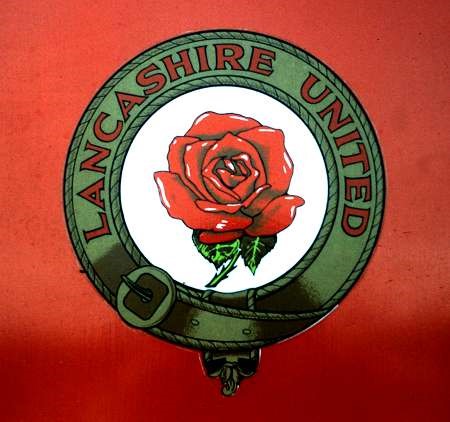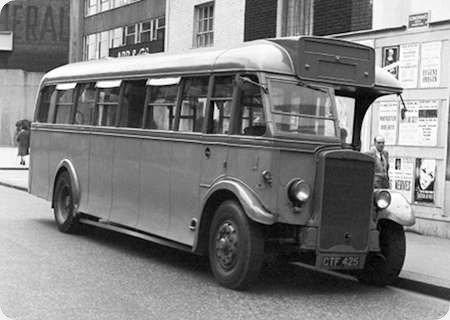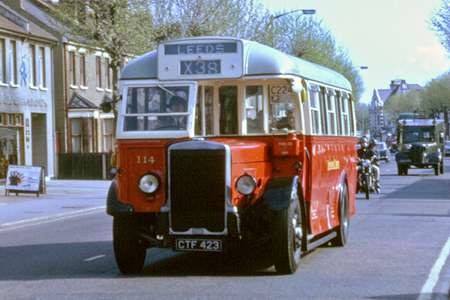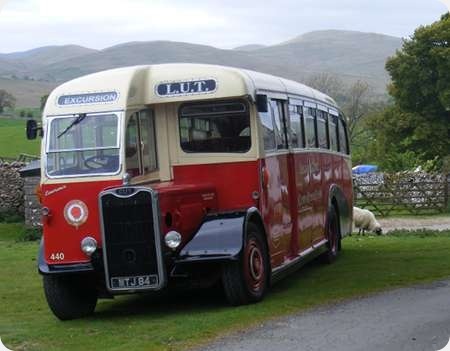
Lancashire United Transport
1961
Guy Arab IV
MCCW H41/32R
534 RTB is a Guy Arab IV from the Lancashire United fleet, once considered by many to be the biggest of the Independents. Regular contributor to this site Neville Mercer, among others, disagrees. It has a Metropolitan Cammell body, to the H73R layout, and was new in 1961. We see it at Duxford on 29 September 1996.

Tis second view being of a close-up of the LUT Crest.
Photograph and Copy contributed by Pete Davies
26/01/17 – 10:30
Among my milder teenage dislikes were tin fronts, Orion bodies and (almost) all-over red liveries, but none of these three features detracts from the magnificence of this vehicle. The matchless reliability of this model and its sound-effects obviously also play a big part in its appeal. Sincere thanks to all that preserve and maintain Guy Arabs!
Ian Thompson
26/01/17 – 14:32
Thanks, Ian. The LUT fleet was something of an oddity in that the indicator layout – in the days I paid any attention to the fleet – was similar to Manchester’s while the livery was more or less in the style of London Transport: red and cream then, when LT went to red and a grey stripe, so did LUT. Finding that this has a MCCW body came as a bit of a surprise, too, because almost all the vehicles I’ve ever seen from their fleet (I know, someone’s going to correct me!) had Northern Counties bodies.
Pete Davies
27/01/17 – 06:27
Pete you are right, the majority of LUT’s Guy Arabs had Northern Counties bodies, both rear and forward entrance. I understand the copy Manchester destination arrangement was the result of a senior manager joining LUT from Manchester sometime in the 1950’s. The same gentleman brought preselect Daimlers into the fleet at the same time. The ‘squared off’ type of font was also used on the destination blinds just the same as Manchester. I always thought LUT was a ‘quality’ operation and although an independent had all the features of a big group company. Many of its routes were lengthy trunk services across what was then South Lancashire. Another operator sadly missed.
Philip Halstead
27/01/17 – 11:27
Thank you, Philip.
Pete Davies
27/01/17 – 11:29
Is this the same vehicle that was parked up in a garden at Greenodd, near Ulverston, Cumbria for quite while in the 1980s?
Larry B
30/01/17 – 07:19
Thanks Pete for posting this photograph.
43 was one of three of this batch allocated to Swinton Depot in the early 70’s (of the batch of ten) I have always thought that LUT gave this body order to MCW as a means of keeping NCME’s prices keen, as LUT were making yearly purchases of Arabs.
They were quite a problem to Guard on the heavier turns due to their total lack of handrails between the seat backs and the ceiling on both decks, when all NCME bodied Guys did have them. Later, when I became a Driver, I found them to be pretty much the same as all the other rear loading Guys, but by then, 43, 44 & 45 were on the part day only list, so were generally to be seen in Trafford Park on work services or peak hour duplicates, as their missing handrails proving unpopular at Swinton. Another of the batch at Atherton, 40 was involved in a pretty bad accident mid sixties and was rebodied by NCME as a front loader.
The unofficial notice in the cab read – dwarfs only! – as being an Arab Mk IV with a Mk V.
Style of body severely reduced head height in the cab!
Mike Norris
30/01/17 – 12:43
Thanks for your comments, Mike. As with any others of my photos on this site, if you’d like him to e-mail you a copy for your own records, our Editor has my permission to do so.
Pete Davies
01/02/17 – 17:03
I remember LUT single deckers running into Radcliffe Bus Station on the 25 service, I think it was. They were mostly Bristol REs with a few Seddons, some had Alexander bodywork with dual doors and all were in the red/grey colour scheme by that time (early 70s).
David Pomfret
02/02/17 – 06:24
As a follow-on the Peter D’s comments, Who vied with LUT as being considered the largest independent bus company at that time?
Chris Hebbron
02/02/17 – 08:23
Chris, I’d have said Barton or West Riding. Please note that Neville discounts West Riding as well, and for the same reasons: not owned by a family local to the area of operations (eg Fishwick) and with most directors based in London. On Neville’s reasoning, it’s Barton.
Pete Davies
02/02/17 – 13:37
I had always heard that Barton was second to LUT, but logically, I would suggest that "independent" had nothing to do with where the owners lived, but whether control was separate from the large groups – e.g. THC, BET. Obviously there was a large element of government control in these groups (and local government in municipal operators), but in today’s scenario I would also exclude the major groups like First, Stagecoach etc. as independents, even though they are free of government control.
Stephen Ford
03/02/17 – 06:12
Hello David,
You are correct about the 25 service to Radcliffe. The 25 and the 13 service to Whitefield were worked by Swinton depots RE,s in the main, both the Plaxton and the Alexander bodied Bristols were always first choice for these routes ( and the 11 and 17 too) their easy steering (in pre power steering made them so) they were just that little bit more nimble on the estate work around Harper Green. I enjoyed these routes as the stretch beyond Ringley was usually quiet and relatively scenic within the bounds of what scenery there was to see in South Lancashire ! Don’t get me wrong, I loved our Seddon RU,s but an RE was the master of these routes.
Mike Norris
03/02/17 – 14:12
Do I read this correctly, Mike? Someone claims to have LOVED the Seddon RU. I knew I shouldn’t have gone to that firm of opticians!!!!! It’s almost like one of the Hamble locals admitting to have watched ‘Howards Way’.
Pete Davies
04/02/17 – 07:15
Hello Pete,
Someone has not been keeping up with LUT and their Seddon RU,s!
Very definitely a great tool for us for on the hardest, longest, busiest one man route the 84. So highly considered that if one became faulty, the union had an understanding with management that if no other RU was available, a maximum of one round trip only was worked before another RU was found. Swinton depots were highly prized if you got one on any other route, great seat, great driving position, strong engine and good brakes.
LUT, were different from most others, with front radiator and full length cardan drive shaft hence their 31 foot six length. If you find a rear view, you will see the body extension. My particular favourite was 339, I would shunt others to gat that one out in the mornings! Yes there is lots in print, especially the Crosville ones, but ours were great.
Mike Norris
04/02/17 – 09:23
Well, as they say, one lives and learns!!! Thanks, Mike.
Pete Davies
05/02/17 – 07:40
Unfamiliar with all the variants on the Orion theme, I don’t know whether this example was significantly lighter than the NCME bodies and therefore chosen to help fuel consumption, as well as for the interesting reason Mike Norris gave: reminding NCME that they weren’t the only fish in the sea!
If the bodies were indeed true lightweights, the buses must have returned nearly 13 mpg.
Ian Thompson
05/02/17 – 09:31
Presumably this bus had the 6LX engine. The 6LW Dennis Lolines of Aldershot & District gave a fleet average of 13.5 mpg, and could turn in almost 16 mpg on the long rural runs, but A&D maintenance was of a very high standard. On the subject of the Orion body and its derivatives, I agree with Ian T – they’re horrible. The straight inward taper of the body sides gave the result a pin headed appearance exacerbated by the deep lower deck/shallow upper deck windows, and the crudity of the front/rear domes. The best examples by far were (again) the Aldershot & District examples which benefited from the lower build and the equal depth of the windows on both decks, and, unlike many (most?) Orions, the interior was equipped to a high standard. Nevertheless, MCW had earned a good reputation over the years for its metal bodywork framing, so presumably the Orion held together reasonably well in service.
Roger Cox
05/02/17 – 12:06
You raise an interesting point, Roger, with your comments. After Alder Valley was formed, from two opposite sides of the fence, one of which always ploughed its own furrow, which of the two management and maintenance regimes dominated?
Chris Hebbron
06/02/17 – 06:43
Chris, when Alder Valley was cobbled together by NBC in 1972, control and ‘management’ was concentrated at Reading. Thus, the worst and scruffiest of the Tilling operators, Thames Valley, subsumed the best of the BET companies, Aldershot & District. Standards didn’t just go downhill, they fell over a cliff. Mercifully, I moved away from Farnborough in 1975, and wasn’t present to witness the continued degeneration in the local public transport scene.
Roger Cox
06/02/17 – 06:44
This was the third and last order for Orion bodies by LUT. In 1955 Cyril Charles Oakham took over as General Manager. Coming from Manchester Corporation where he had been Chief Engineer, he was to make a number of changes, the first of which to order 24 Daimler CVG5s which arrived in 1956 with 61 seat Orion bodies. Obviously Oakham did not share his former boss’s antipathy to the Orion. These appeared in a revised livery of all over red apart from a single cream band above the lower deck windows, as was soon to appear at MCTD, and with the Manchester style number, via and destination box layout. His next change was to order PD3/4s and Daimler CSG6/30s as trolleybus replacements, the former with Orion, the latter with NCME bodies. The last Leyland, 657, was the highest fleet number used by LUT as the system started again at 1 with the first of six Plaxton bodied Reliances. The batch illustrated by the example above gave LUT a rare distinction of operating Orion bodies on chassis from three of the then major manufacturers. In between times, and thereafter, NCME continued to be favoured with orders for bodies and Guy predominated with Daimler later picking up some Fleetline orders which, had the Wulfrunian lived up to its billing, would not have been built. Why did Leyland, Daimler and MCW win the front engined vehicle orders from LUT? The evidence is that initially Oakham wanted a second string supplier for double decker chassis a la Manchester and NCME’s tenders were not always the most competitive.
Phil Blinkhorn
11/02/17 – 06:32
I like Seddon RUs so much I own one…
The LUT Arab at Greenodd was 166 I believe, it was painted as a Laurel and Hardy Museum bus and is stored at St Helens Transport Museum presently.
Paul Turner
02/08/17 – 07:10
I’m going to leave a rebuttal to Roger Cox’s evaluation of ‘Avashot and Riskit versus Thames Valley. Most of my 25 years were spent in the coach side of things where the general focus was on the passenger and the experience they had. Viewed from that angle, but not suggesting for a moment that there weren’t good and bad in all companies, I’d far rather have tried to do business in High Wycombe booking office in the 70s than in Aldershot. Those companies that tried to develop their services would project a far more user friendly attitude than would the stick in the mud ‘buses only’ type.
Who would compare Western National with A&D, or Midland Red with Maidstone & District as ‘quality’ companies, and where would we be more likely to hear ‘This job would be all right if it wasn’t for the public.’? I started life with another of the ‘glamour’ companies, Southdown, but even there I once took a service over mid-route and heard an old lady say ‘Oh good. We’ve got the cheerful one.’ which doesn’t say much for my colleagues of the time.
Within ‘our’ industry we can, and do, wax lyrical about the internal aspects of what we do, but it’s the paying passenger who makes it all possible.
Nick Turner
03/08/17 – 06:54
My in-laws, from Woking, always called A&D "All aboard and Riskit!"
I’m not sure whether people at the pointy end, conductors and later/now drivers, were ever told to project a friendly manner towards their passengers, although I do recall helpfulness towards the frailer members of society and children, like helping them up and down from high rear platforms. I certainly (as a near 80-year-old) don’t recall smiles and banter as being the norm in those days. Strangely, the current habit of thanking the driver, from descending passengers, seems to have become a pleasant habit(at least in Gloucestershire) and has led to some sort of driver/passenger rapport. Is this habit only local or more general elsewhere?
Chris Hebbron
03/08/17 – 15:07
I’d never heard that variation for A&D, Chris, but the awarding of usually derisory nicknames seemed to reflect their public image, hence my defence of Thames Valley. One never heard nicknames for East Kent or Southdown – but Maidstone & District, in the middle, was always ‘Mud ‘n’ Dust’ or ‘Muddle ‘n’ Dawdle’. ‘Pants & Corsets’ for H&D was widespread and even ‘Nine Elms’ for Lincolnshire Road Car, based on the similarity of their livery with the paint company. Indeed, promotion within NBC (No Bugger Cares) followed distinct patterns and a move to one of the bigger names like United Auto, Bristol Omnibus, Crosville etc was, in itself, regarded as a promotion whereas Lincs Road Car had a reputation as being the NBC equivalent of the ‘naughty step’.
Certainly in rural areas, the closing of the Dormy Sheds was the thin end of a very nasty wedge.
Nick Turner
01/09/17 – 06:05
In belated reply to Roger Cox, LUT’s Arabs did not have 6LX engines. One did (no.27), but it was found that the Guy clutch didn’t like the 6LX torque, and the necessary modifications made the bus very difficult to drive.
Peter Williamson
06/09/17 – 06:35
With a nifty sidestep from buses to railways, Nick, I wonder if ‘First Great Western’ changed its name to ‘GWR’ because its poor reputation caused it to commonly be nicknamed ‘Worst Great Western!’
Chris Hebbron
08/09/17 – 06:38
One could be charitable, Chris, and blame the change on a nostalgic wish?
Nick Turner
05/10/20 – 06:38
534 RTB past to ETC members Mick Betterton & Syd Eade 8/20
John Wakefield





